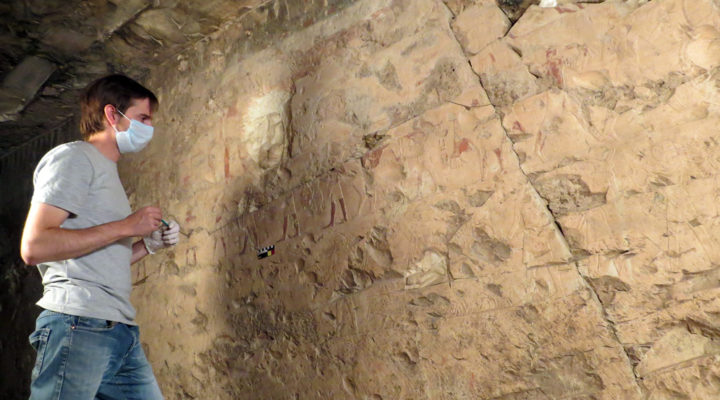Archeology
From Catamarca to Egypt: Argentine archeologist was called to analyze an ancient Thebes tomb
Lucas Gheco conducts excavation and documentation tasks in a 3500 years old tomb in Luxor.
Lucas Gheco, archeologist of the National Scientific and Technical Research Council, started his professional career in 2006 when he moved from his birthplace in the city of Santa Fe to Catamarca to obtain a degree in archeology in the National University of Catamarca (UNCa). In 2017, as a scholar, he obtained a PhD in Anthropological Sciences at the National University of Córdoba (UNC). Since then, his workplace has been the Research and Transference Center (CIT) Catamarca (CONICET-UNCa) and now he conducts his postdoctoral studies on Archeology and Cultural Heritage. He is also a professor at the Research Institute of Cultural Heritage at the National University of San Martin (UNSAM).
To unravel that complex “story on the wall”
Currently, Dr. Gheco is part of a joint mission between researchers from Argentina and Brazil, with the cooperation of the Egyptian Ministry of Antiquities in Luxor, ancient Thebes. It is there that a research team conducts excavations and documentation tasks to know about a tomb from the ancient Theban necropolis. The tomb belonged to Amenemhat, a scribe, a supervisor of barns and bread accountant that lived during the kingdom of Tutmosis III, who ruled Egypt from c. 1479 to 1425 BC.
The project, which was led by Dr Bernarda Marconetto, CONICET independent researcher at the Anthropology Institute of Córdoba (IDACOR, CONICET-UNC) and Dr. José Pellini of the Universidade Federal de Minas Gerais, adopts a decolonized perspective of Egyptian archeology to transcend the focus on the pharaonic period and include the amount of the reuse episodes of the tomb up to now.
The study conducted by Lucas Gheco focuses on the analysis of complex stories of building and transformation of the walls, painted roofs and prints on the tomb. “This tomb was made almost 3500 years ago but the walls do not only contain the motives of that first “inauguration” moment but also the long history whose last marks are no more than some decades old.”
The researcher says that from the detailed observation of small overlaps between the figures, the techniques used in the making, the style differences between the motives, and other hints, we can unravel that complex “story on the wall” and know each of the episodes that took part and modified it. Although we are conducting fieldwork, there are some elements to start to analyze the two different moments of painting done during the pharaonic period and the relatively modern time in which the tomb was occupied by the local populations that have lived in the Theban necropolis for centuries. There are also some indicators on the walls that seem to be linked to other episodes, although this has to be better explored in the following years.”
From Catamarca to Egypt
The proposal to do research in Egypt is the result of more than ten years of work exploring cave paintings in different archeological sites, especially in Oyola, Catamarca. “I was invited to Egypt to use a methodology we’d used and perfected to analyze pre-Hispanic cave art in the range of El Alto-Ancasti, in the east of Catamarca. There, together with a big team of researchers and students who belonged to institutions such as CONICET, the UNCa, the UNSAM and the UNC, we explore the history of use, production and modifications of the caves with rock art”, Gheco affirms.
And adds: “From the combination of in-depth visual analysis of the walls, stratigraphic excavation of sediments from the caves and the chemical analysis of small samples of paint, we managed to recognize a long historical process of occupations of the shelters and transformations in the stone friezes. We aim to apply this methodology in Egypt, although now it is only limited to the visual analysis of the walls. We think this approach provides a vision of the past in which the complexity of history, shades, changes and tensions are expressed.”
As regard future challenges, Ghecco is focused on his postdoctoral scholarship and his studies on cave art in the east of Catamarca, in Oyola and in other nearby archeological sites. “it’s really rewarding to apply this methodology and technical alternatives to the analysis in other places, away form social, space and temporal terms. Egypt is a great opportunity for that, not only as a field of application but also as laboratory to test new approaches that I hope can help to enhance the study of cave art in Catamarca”, the archeologist concludes.
By Sergio Patrone Firma Paz
